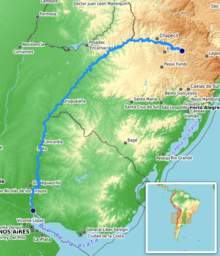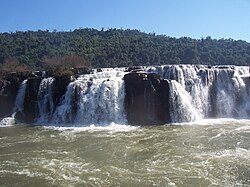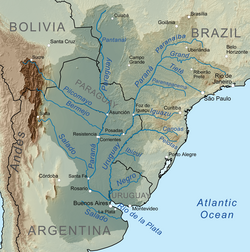The Uruguay River (Spanish: Río Uruguay [ˈri.o wɾuˈɣwaj]; Portuguese: Rio Uruguai [ˈʁi.u uɾuˈɡwaj]) is a major river in South America. It flows from north to south and forms parts of the boundaries of Brazil, Argentina and Uruguay, separating some of the Argentine provinces of La Mesopotamia from the other two countries. It passes between the states of Santa Catarina and Rio Grande do Sul in Brazil; forms the eastern border of the provinces of Misiones, Corrientes and Entre Ríos in Argentina; and makes up the western borders of the departments of Artigas, Salto, Paysandú, Río Negro, Soriano and Colonia in Uruguay.
| Uruguay River | |
|---|---|
 Sunset in the Uruguay River, from Misiones, Argentina | |
 Map of the Uruguay River | |
| Native name |
|
| Location | |
| Countries | |
| Physical characteristics | |
| Source | Pelotas River |
| • location | Serra Geral, Brazil |
| • elevation | 1,800 m (5,900 ft) |
| 2nd source | Canoas River |
| • location | Serra Geral, Brazil |
| Mouth | Río de la Plata |
• location | Argentina, Uruguay |
• coordinates | 34°12′S 58°18′W / 34.200°S 58.300°W[1] |
• elevation | 0 m (0 ft) |
| Length | 1,838 km (1,142 mi)[2] |
| Basin size | 365,000 km2 (141,000 sq mi)[3] |
| Discharge | |
| • location | Nueva Palmira (near mouth) |
| • average | (Period 1971–2010)7,058 m3/s (249,300 cu ft/s)[4] |
| Discharge | |
| • location | Concordia, Salto Grande |
| • average | (Period 1971–2010)5,725 m3/s (202,200 cu ft/s)[4] |
| Discharge | |
| • location | Paso de los Libres |
| • average | (Period 1971–2010)4,789 m3/s (169,100 cu ft/s)[4] |
| Discharge | |
| • location | El Soberbio |
| • average | (Period 1971–2010)2,384 m3/s (84,200 cu ft/s)[4] |
| Basin features | |
| Progression | Río de la Plata → Atlantic Ocean |
| River system | Río de la Plata |
| Tributaries | |
| • left | Pelotas, Inhandava, Apuaê, Passo Fundo, Rio da Várzea, Guarita, Turvo, Buricá, Ijuí, Piratini, Icamaquã, Ibicuí, Cuareim, Arapey Grande, Queguay Grande, Daymán, Negro, San Salvador |
| • right | Canoas, Peixe, Irani, Chapecó, Das Antas, Pepiri-Guazu, Arroyo Yabotí, Aguapey, Miriñay, Mocoretá, Gualeguaychú |


Etymology
editThe name of the river tends to comes from the Spanish settlers' interpretation of the Guaraní language word the inhabitants of the region used to designate it. There are several interpretations, including "the river of the uru (an indigenous bird)", and "[river of] the uruguá" (an indigenous gastropod, Pomella megastoma).[5]
Course
editThe river measures about 1,838 km (1,142 mi) in length and starts in the Serra do Mar in Brazil,[6][7][8][9][10] where the Canoas River and the Pelotas River are joined, at about 200 metres (660 ft) above mean sea level. At this stage, the river goes through uneven, broken terrain, forming rapids and falls. Its course through Rio Grande do Sul is not navigable.
An unusual feature of the Uruguay River is a submerged canyon. This canyon formed during the Ice Age, when the climate was drier and the river was narrower. Its depth is up to 100 metres (330 ft) below the bottom of the river channel and it is 1/8 to 1/3 as wide as the river.[9][11] The canyon is only visible in two places, one of which is the Moconá Falls (also called the Yucumã Falls). However, the falls are not visible for 150 days per year and become more like rapids when they are not visible. Unlike most waterfalls, the Moconá Falls are parallel to the river, not perpendicular. The falls are 10 metres (33 ft) to 12 metres (39 ft) high and between 1,800 metres (5,900 ft) and 3,000 metres (9,800 ft) wide. They are 1,215 km (755 mi) from the mouth of the river.[9][11] The 17,491 ha (43,220 acres) Turvo State Park, created in 1947, protects the Brazilian side of the falls.[12]
Together with the Paraná River, the Uruguay forms the Río de la Plata estuary. It is navigable from around Salto Chico. Its main tributary is the Río Negro, which is born in the south of Brazil and goes through Uruguay for 500 km until its confluence with the Uruguay River, which is located 100 km north of the Uruguay's confluence with the Río de la Plata, in Punta Gorda, Colonia Department, Uruguay.
The river is crossed by five international bridges called (from north to south): Integration Bridge and Paso de los Libres-Uruguaiana International Bridge, between Argentina and Brazil; and the Salto Grande Bridge, General Artigas Bridge and Libertador General San Martín Bridge between Argentina and Uruguay.
The drainage basin of the Uruguay River has an area of 365,000 km2 (141,000 sq mi).[3] Its main economic use is the generation of hydroelectricity and it is dammed in its lower portion by the Salto Grande Dam and by the Itá Dam upstream in Brazil.
Discharge
editUruguay River at Salto Grande:
| Year | Average monthly discharge (m3/s) | ||||||||||||
|---|---|---|---|---|---|---|---|---|---|---|---|---|---|
| JAN | FEB | MAR | APR | MAY | JUN | JUL | AUG | SEP | OCT | NOV | DEC | Average | |
| 2014 | 4,652 | 3,858 | 3,910 | 4,277 | 7,104 | 8,332 | 16,199 | 5,065 | 7,298 | 12,873 | 5,862 | 6,241 | 7,139.2 |
| 2015 | 13,471 | 4,543 | 3,622 | 2,450 | 2,450 | 5,945 | 11,865 | 7,855 | 3,731 | 14,948 | 13,155 | 18,559 | 8,549.5 |
| 2016 | 10,690 | 5,206 | 4,569 | 13,535 | 6,758 | 4,204 | 5,609 | 3,098 | 3,947 | 6,937 | 6,931 | 2,630 | 6,176.2 |
| 2017 | 6,231 | 4,885 | 5,680 | 8,712 | 13,748 | 21,136 | 3,684 | 5,865 | 5,801 | 7,537 | 3,588 | 1,971 | 7,399 |
| 2018 | 3,086 | 2,902 | 2,397 | 3,137 | 5,355 | 2,784 | 4,057 | 2,478 | 6,071 | 8,208 | 8,044 | 6,714 | 4,602.7 |
| 2019 | 16,384 | 4,850 | 5,264 | 3,647 | 10,389 | 6,650 | 4,066 | 4,395 | 2,549 | 4,066 | 8,687 | 3,628 | 5,774.7 |
| 2020 | 1,459 | 1,679 | 831 | 581 | 2,315 | 5,056 | 7,318 | 3,893 | 3,418 | 1,785 | 700 | 2,079 | 2,592.8 |
| 2021 | 5,570 | 939 | 1,734 | 1,724 | 4,589 | 4,975 | 2,017 | 1,801 | 4,499 | 4,373 | 1,229 | 1,283 | 2,894.4 |
| 2022 | 5,665 | 986 | 6,363 | 9,211 | 10,098 | 2,896 | 2,513 | 482 | 472 | 7,671 | 2,035 | 7,105 | 4,624.7 |
| 2023 | 569 | 677 | 1,435 | 1,082 | 2,707 | 9,778 | 6,388 | 3,451 | 11,210 | 16,536 | 22,898 | 14,101 | 7,569.3 |
| 2024 | 7,714 | 3,384 | 2,826 | 9,473 | 18,397 | 8,339 | 7,815 | 5,382 | 4,260 | ||||
| Source: Comisión Nacional de Energía Atómica[13] | |||||||||||||
Mean annual discharge at mouth: 217 km3/a (6,900 m3/s)–228 km3/a (7,200 m3/s)[14][15]
Tributaries
editThe main tributaries from the mouth:
| Left
tributary |
Right
tributary |
Length
(km) |
Basin size
(km2) |
Average discharge
(m3/s)* |
|---|---|---|---|---|
| Uruguay | 1,838 | 353,451 | 7,562.4 | |
| Lower Uruguay | ||||
| San Salvador | 100 | 3,072.1 | 52.5 | |
| Negro | 903 | 71,154 | 952.1 | |
| Guale-guaychú | 268 | 6,935.8 | 84 | |
| Arroyo Negro | 2,271.2 | 37.9 | ||
| Queguay Grande | 280 | 8,596 | 157.7 | |
| Daymán | 210 | 3,415 | 63.3 | |
| Middle Uruguay | ||||
| Arroyo Itapebí Grande | 1,042.2 | 19.1 | ||
| Arapey Grande | 240 | 11,996 | 234.9 | |
| Arroyo Yacuy | 1,089.5 | 20.6 | ||
| Mocoretá | 140 | 3,783.3 | 59.3 | |
| Cuareim | 351 | 14,641 | 326.5 | |
| Miriñay | 285 | 12,473.6 | 168.2 | |
| Arroio Touro Passo | 991.9 | 22.7 | ||
| Guaviraví | 1,765.8 | 34.7 | ||
| Ibicuí | 673 | 47,203.4 | 1,113.1 | |
| Aguapey | 310 | 7,088.2 | 163.6 | |
| Icamaquã | 250 | 4,886.7 | 132.3 | |
| Piratini | 120 | 5,611 | 152.4 | |
| Ijuí | 300 | 10,794 | 307 | |
| Comandaí | 199 | 1,418 | 40 | |
| Santo Cristo | 121.7 | 899.2 | 24.2 | |
| Santa Rosa | 185.1 | 1,401.5 | 38.9 | |
| Buricá | 195.5 | 2,356.2 | 66.4 | |
| Arroyo Soberbio | 133.1 | 1,084.7 | 23.7 | |
| Turvo | 247.1 | 1,877.7 | 53.2 | |
| Arroyo
Yabotí |
2,002.4 | 53.4 | ||
| Upper Uruguay | ||||
| Pepiri | 180 | 2,345.6 | 74.4 | |
| Guarita | 242 | 2,234 | 66.8 | |
| Rio das | 194 | 2,706.1 | 81.7 | |
| Rio da Várzea | 165 | 5,480.5 | 183.8 | |
| Chapecó | 248 | 8,364.1 | 284.1 | |
| Passo Fundo | 200 | 4,055 | 135.7 | |
| Irani | 223 | 1,586.5 | 50.1 | |
| Jacutinga | 168 | 1,003.2 | 29.8 | |
| Peixe | 299 | 5,286.8 | 143.7 | |
| Apauê | 210 | 3,729.8 | 124.7 | |
| Inhandava | 181.7 | 2,406 | 73.5 | |
| Pelotas | 437 | 13,378.4 | 343.5 | |
| Canoas | 572 | 14,883.7 | 308.8 | |
| Source:[16][4] | ||||
* Period: 1971–2000
Cellulose plant conflict
editThis section needs additional citations for verification. (May 2014) |
Argentina and Uruguay experienced a conflict over the construction of pulp mills on the Uruguay River. Two European companies, ENCE and Botnia, proposed building cellulose processing plants at Fray Bentos, Uruguay, opposite Gualeguaychú, Argentina. According to a 1975 treaty, Argentina and Uruguay were supposed to jointly agree on matters relating to the Uruguay River.[17] Argentina alleged that Uruguay broke the treaty. Additionally, Argentina believed the Finnish company Botnia was polluting the fish and the overall environment of the river while Uruguay believed that the plant was not depositing a large amount of toxins in the Uruguay River.[18]
Starting in April 2005, residents of Gualeguaychú, as well as many others, protested, claiming that the plants would pollute the river shared by the two countries. Early in 2006, the conflict escalated into a diplomatic crisis,[citation needed] compelling one of the companies move the project 250 kilometres (160 mi) south. Beginning in December 2005, the international bridges linking the Argentine province of Entre Ríos with Uruguay were intermittently blockaded by Argentine protesters, causing major disruptions in commercial traffic and tourism.
In 2006, Argentina brought the dispute before the International Court of Justice. The ICJ completed hearings between Argentina and Uruguay regarding the dispute on October 2, 2009. In 2010, the court ruled that although Uruguay failed to inform Argentina of the construction of the pulp mills, the mills did not pollute the river, so closing the remaining pulp mill would be unjustified. Later in 2010, Argentina and Uruguay created a joint commission to coordinate activities on the river.
Links across the Uruguay
editThe course of the Uruguay is crossed by the following bridges, beginning upstream:
See also
editReferences
edit- ^ Uruguay River at GEOnet Names Server
- ^ "Río de la Plata". Encyclopædia Britannica. Retrieved 14 August 2010.
- ^ a b Varis, Olli; Tortajada, Cecilia; Biswas, Asit K. (2008). Management of Transboundary Rivers and Lakes. Springer. p. 272. ISBN 978-3-540-74926-4.
- ^ a b c d e "Transboundary Diagnostic Analysis for the La Plata Basin".
- ^ El País newspaper: Presentan tesis del nombre Uruguay Archived 14 March 2012 at the Wayback Machine, (in Spanish) Retrieved 21 November 2014.
- ^ Rio Uruguay
- ^ "CONICET | Buscador de Institutos y Recursos Humanos". www.conicet.gov.ar. Retrieved 6 October 2019.
- ^ FACULDADE DE BIOCIÊNCIAS PROGRAMA DE PÓS-GRADUAÇÃO EM BIOCIÊNCIAS – ZOOLOGIA
- ^ a b c "A particular canyon excavated in the large Uruguay River channel (South America)".
- ^ The fish fauna of two tributaries of the passo fundo river, uruguay river basin, rio grande do sul, brazil
- ^ a b "Moconá Falls (Yucumã Falls)". Wondermondo. 15 February 2012.
- ^ PES do Turvo (in Portuguese), ISA: Instituto Socioambiental, retrieved 11 November 2016
- ^ "Síntesis del Mercado Eléctrico Mayorista".
- ^ "Transboundary River Basin Overview – La Plata" (PDF).
- ^ Isupova, M. V.; Mikhailov, V. N. (16 November 2018). "Long-Term Variations of Water Runoff and Suspended Sediment Yield in the Parana and Uruguay Rivers". Water Resources. 45 (6): 846–860. doi:10.1134/S0097807818060088. S2CID 135342646. Retrieved 1 January 2022.
- ^ "Parana (La Plata)".
- ^ Helsingin Sanomat. "Pulp mill dispute between Argentina and Uruguay intensifies". Retrieved 26 May 2014.
- ^ "Argentina y Uruguay ya esperan fallo de la CIJ en diferendo sobre pastera". AFP, Por Anna Pelegrí. Archived from the original on 12 April 2010. Retrieved 10 February 2009.
External links
editMedia related to Uruguay River at Wikimedia Commons